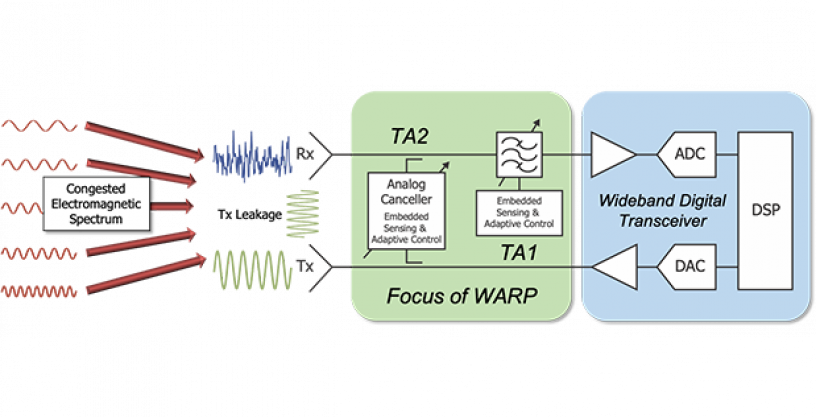Summary

Over the last decade, wideband analog-to-digital converter (ADC) technology has improved in both bandwidth and resolution to a point that wideband RF sampling receivers are now a reality.
However, wideband ADCs typically have less spur-free dynamic range as compared to their narrowband counterparts and are typically exposed to more signals simultaneously due to the wide bandwidth. Despite the advantages associated with more bandwidth, the dynamic range limitation can prevent the use of wideband receivers in multi-function applications that support wideband electromagnetic spectrum operations (EMSO).
The Wideband Adaptive RF Protection (WARP) program seeks develop wideband adaptive filtering and signal cancellation architectures to protect emerging wideband receivers against both external and self-interference, ultimately enabling the use of wideband software-defined radios in contested and congested spectral environments.
To accomplish its goals, WARP is focused on two key technical areas:
- In technical area 1, the focus is on mitigating external interference in the 2-18 GHz band with tunable filtering that can adapt to the signals present in the spectrum. This will be accomplished by first targeting new filter architectures and associated underlying technology to achieve a 2:1 and 3:1 tuning ratio in Phase 1 and Phase 2 of the program, respectively, before culminating in full-band coverage by the end of the program.
- In technical area 2, the focus is on mitigating self-interference from a co-located transmitter in the 0.1-6 GHz band to enable same-frequency simultaneous transmit and receive (STAR). To achieve wideband operation, this will require the canceller to have a time-bandwidth product of approximately 10 by the end of the program, well beyond the state-of-the-art in simple resonant RF canceller circuits.
In these new approaches to wideband reconfigurable filtering and signal cancellation, it is expected that the number of tuning inputs could be large. To manage this tuning challenge, it is expected that the hardware will adapt to the environment in real-time through embedded sensing and control.
If successful, by the end of the program, when exposed to external or self-interference, WARP filters and cancellers will autonomously adapt to the spectral environment to protect a wideband RF receiver.
